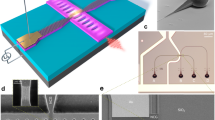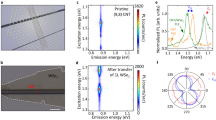Abstract
The range of luminescent materials that can be used in electroluminescent devices is limited due to material processing challenges and band alignment issues. This impedes the development of electroluminescent devices at extreme wavelengths and hinders the use of electroluminescence spectroscopy as an analytical technique. Here, we show that a two-terminal device that uses an array of carbon nanotubes as the source contact can excite electroluminescence from various materials independent of their chemical composition. Transient band bending, created by applying an a.c. gate voltage, is used to achieve charge injection across different band alignments. As a result, the device can produce electroluminescence from long-wave infrared (0.13 eV) to ultraviolet (3.3 eV) wavelengths depending on the emitting material drop-casted on top of the nanotube array, and with onset voltages approaching the optical energy gap of the emitting material. We show that our device can be used to probe a chemical reaction in a liquid droplet via electroluminescence spectroscopy and can be used as an electroluminescence sensor for detecting organic vapours.
This is a preview of subscription content, access via your institution
Access options
Access Nature and 54 other Nature Portfolio journals
Get Nature+, our best-value online-access subscription
$29.99 / 30 days
cancel any time
Subscribe to this journal
Receive 12 digital issues and online access to articles
$119.00 per year
only $9.92 per issue
Buy this article
- Purchase on Springer Link
- Instant access to full article PDF
Prices may be subject to local taxes which are calculated during checkout






Similar content being viewed by others
Data availability
The data that support the plots within this paper and other findings of this study are available from the corresponding author upon reasonable request.
References
Chao, T.-C. et al. Highly efficient UV organic light-emitting devices based on bi(9,9-diarylfluorene)s. Adv. Mater. 17, 992–996 (2005).
Kneissl, M., Seong, T.-Y., Han, J. & Amano, H. The emergence and prospects of deep-ultraviolet light-emitting diode technologies. Nat. Photon. 13, 233–244 (2019).
Li, X. et al. Bright colloidal quantum dot light-emitting diodes enabled by efficient chlorination. Nat. Photon. 12, 159–164 (2018).
Liu, Y., Li, C., Ren, Z., Yan, S. & Bryce, M. R. All-organic thermally activated delayed fluorescence materials for organic light-emitting diodes. Nat. Rev. Mater. 3, 18020 (2018).
Yao, Y., Hoffman, A. J. & Gmachl, C. F. Mid-infrared quantum cascade lasers. Nat. Photon. 6, 432–439 (2012).
Pan, Y. et al. Recent advances in alternating current-driven organic light-emitting devices. Adv. Mater. 29, 1701441 (2017).
Kong, S. H., Lee, J. I., Kim, S. & Kang, M. S. Light-emitting devices based on electrochemiluminescence: comparison to traditional light-emitting electrochemical cells. ACS Photon. 5, 267–277 (2018).
Fresta, E. & Costa, R. D. Beyond traditional light-emitting electrochemical cells—a review of new device designs and emitters. J. Mater. Chem. C 5, 5643–5675 (2017).
Cho, S. H. et al. Extremely bright full color alternating current electroluminescence of solution-blended fluorescent polymers with self-assembled block copolymer micelles. ACS Nano 7, 10809–10817 (2013).
Jayathilaka, W. A. D. M., Chinnappan, A., Tey, J. N., Wei, J. & Ramakrishna, S. Alternative current electroluminescence and flexible light emitting devices. J. Mater. Chem. C 7, 5553–5572 (2019).
Russ, M. J. & Kennedy, D. I. The effects of double insulating layers on the electroluminescence of evaporated ZnS:Mn films. J. Electrochem. Soc. 114, 1066–1072 (1967).
Fischer, A. G. Electroluminescent lines in ZnS powder particles: II. Models and comparison with experience. J. Electrochem. Soc. 110, 733–748 (1963).
Perumal, A., Lüssem, B. & Leo, K. High brightness alternating current electroluminescence with organic light emitting material. Appl. Phys. Lett. 100, 103307 (2012).
Chen, Y. et al. Solution-processable hole-generation layer and electron-transporting layer: towards high-performance, alternating-current-driven, field-induced polymer electroluminescent devices. Adv. Funct. Mater. 24, 2677–2688 (2014).
Lien, D.-H. et al. Large-area and bright pulsed electroluminescence in monolayer semiconductors. Nat. Commun. 9, 1229 (2018).
Wang, C. et al. Extremely bendable, high-performance integrated circuits using semiconducting carbon nanotube networks for digital, analog, and radio-frequency applications. Nano Lett. 12, 1527–1533 (2012).
Sung, J. et al. AC field-induced polymer electroluminescence with single wall carbon nanotubes. Nano Lett. 11, 966–972 (2011).
Chen, Y. et al. Effect of multi-walled carbon nanotubes on electron injection and charge generation in AC field-induced polymer electroluminescence. Org. Electron. 14, 8–18 (2013).
McCarthy, M. A. et al. Low-voltage, low-power, organic light-emitting transistors for active matrix displays. Science 332, 570–573 (2011).
Keuleyan, S., Lhuillier, E. & Guyot-Sionnest, P. Synthesis of colloidal HgTe quantum dots for narrow mid-IR emission and detection. J. Am. Chem. Soc. 133, 16422–16424 (2011).
Nobeshima, T., Nakakomi, M., Nakamura, K. & Kobayashi, N. Alternating-current-driven, color-tunable electrochemiluminescent cells. Adv. Opt. Mater. 1, 144–149 (2013).
Ahn, J. H., Wang, C., Perepichka, I. F., Bryce, M. R. & Petty, M. C. Blue organic light emitting devices with improved colour purity and efficiency through blending of poly(9,9-dioctyl-2,7-fluorene) with an electron transporting material. J. Mater. Chem. 17, 2996–3001 (2007).
Rudmann, H. & Rubner, M. F. Single layer light-emitting devices with high efficiency and long lifetime based on tris(2,2′ bipyridyl) ruthenium(II) hexafluorophosphate. J. Appl. Phys. 90, 4338–4345 (2001).
Kang, G.-W., Ahn, Y.-J., Park, D. Y. & Lee, C. Efficient blue electroluminescence from 9,10-diphenylanthracene. Proc. SPIE 4800, 208–215 (2003).
Snow, E. S., Novak, J. P., Campbell, P. M. & Park, D. Random networks of carbon nanotubes as an electronic material. Appl. Phys. Lett. 82, 2145–2147 (2003).
Jin, Y., Yu, C., Denman, R. J. & Zhang, W. Recent advances in dynamic covalent chemistry. Chem. Soc. Rev. 42, 6634–6654 (2013).
Nakamura, T., Sharma, D. K., Hirata, S. & Vacha, M. Intrachain aggregates as the origin of green emission in polyfluorene studied on ensemble and single-chain level. J. Phys. Chem. C 122, 8137–8146 (2018).
Zhao, Y. et al. Synthesis of porphyrin-based two-dimensional metal–organic framework nanodisk with small size and few layers. J. Mater. Chem. A 6, 2828–2833 (2018).
Amani, M. et al. Near-unity photoluminescence quantum yield in MoS2. Science 350, 1065–1068 (2015).
Acknowledgements
This work was supported by the Electronic Materials Program, funded by the Director, Office of Science, Office of Basic Energy Sciences, Materials Sciences and Engineering Division of the US Department of Energy under contract no. DE-AC02-05Ch11231. We thank M. Amani, H. Kim and S. Z. Uddin for help with the optical measurement instrument set-up. Work at the Molecular Foundry was supported by the Office of Science, Office of Basic Energy Sciences of the US Department of Energy under contract no. DE-AC02-05CH11231. V.W. acknowledges support from the NSF Graduate Research Fellowship (grant no. DGE-1752814).
Author information
Authors and Affiliations
Contributions
Y.Z. and A.J. conceived the idea for the project. Y.Z., D.-H.L. and V.W. carried out optical measurements. V.W. carried out the device simulation. Y.Z. and V.W. fabricated devices and wrote the manuscript. All authors commented on the results and manuscript.
Corresponding author
Ethics declarations
Competing interests
The authors declare no competing interests.
Additional information
Publisher’s note Springer Nature remains neutral with regard to jurisdictional claims in published maps and institutional affiliations.
Supplementary information
Supplementary Information
Supplementary Figs. 1–20, Tables 1–5, note and refs. 30–34.
Rights and permissions
About this article
Cite this article
Zhao, Y., Wang, V., Lien, DH. et al. A generic electroluminescent device for emission from infrared to ultraviolet wavelengths. Nat Electron 3, 612–621 (2020). https://doi.org/10.1038/s41928-020-0459-z
Received:
Accepted:
Published:
Issue Date:
DOI: https://doi.org/10.1038/s41928-020-0459-z
This article is cited by
-
Electroluminescence from nanocrystals above 2 µm
Nature Photonics (2022)
-
Materials and devices for flexible and stretchable photodetectors and light-emitting diodes
Nano Research (2021)



